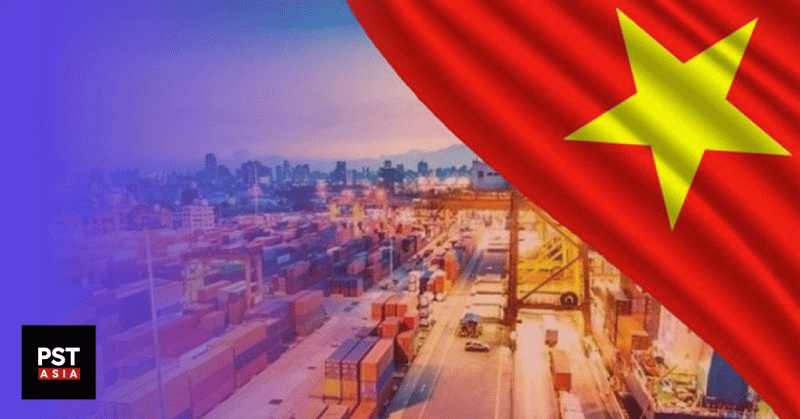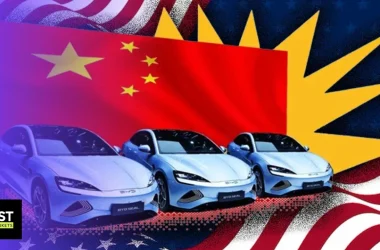China is known as the world’s factory and the largest manufacturing country, but it’s becoming harder for foreign investors to do business there due to increasing prices, intellectual property theft, increased competition locally and geopolitical tensions.
It was only natural that manufacturers started looking for alternatives, and one of those is the emerging Southeast Asian country of Vietnam. Can the country that attracted investments from Samsung, LG, Intel and Apple become the new China? And what is fueling its astonishing growth?
Vietnam’s quick rise after the war
Vietnam’s rise to power is even more impressive when you understand how far it has come in 30 short years.
The Vietnam War, which began in November of 1955 and ended in April of 1975, left the country a total ruin. It was one of the poorest countries in the world. The war was followed by more conflict inside the country and by the mid-1980s, GDP per capita was between $200 and $300. This left 70% of Vietnam’s population living under the poverty line.
However, these conditions changed in 1986, when the Vietnamese government introduced the “Đổi Mới” campaign of economic and political reforms. The campaign encouraged the establishment of a free-market economy, combined with government efforts to oversee and enforce the reforms. It also encouraged the establishment of private businesses and foreign investments. Vietnam began investing in human capital during this time and signing free-trade agreements with various countries.
The campaign brought very positive results and in 1989, Vietnam managed to export 1.4 million tons of rice, a great achievement for a country that faced food shortages and starvation.
Vietnam saw continuous economic growth in the years following the Đổi Mới, recording an average annual economic growth of 6.5% over that period, one of the highest rates among developing countries. In 2008, the per capita GDP was $1,000, and for 2022 it was $4,164. It also had a GDP growth rate of 8.02% in 2022.
The economy of Vietnam was helped a lot by a stable political situation during the past few years and the population was able to grow thanks to the stability, with 70% of Vietnam’s current population born after the war. Only 20% of the population today lives in poverty and the status of education greatly improved as 95% of Vietnamese people today are literate.
A landmark deal
The Vietnamese government’s continuous encouragement of free-trade and foreign investment brings us to September of this year, when President Joe Biden visited Vietnam to strengthen relations between Washington and Hanoi.
During the visit, he emphasized the importance of an economic alliance between the two countries, highlighting America’s desire for an Asian ally to offset tensions with China and the ambitions both countries have for key technologies, such as chip manufacturing.
Vietnam is an emerging player in the semiconductor chip market, and it’s starting to be seen as a cheaper alternative to Taiwan. It’s becoming harder to rely solely on Taiwan in this industry because of concentration risk, causing countries like the U.S. and the Netherlands to encourage growth in the Vietnamese semiconductor sector.
When Biden returned from this visit, he announced a landmark deal between the Boeing Company and Vietnam Airlines. The airline agreed to buy 50 of Boeing’s 737 Max jets for $7.8 billion.
It’s no surprise the airline is investing in new equipment since the country’s aviation market has been growing rapidly. According to the Civil Aviation Authority of Vietnam, Vietnam’s aviation market grew 41.8% in the first seven months of 2023.
Fueling this growth is the Southeast Asia aviation market which was valued at $34.40 billion in 2023. Demand from travelers for both tourism and business has made this region a hotbed for aviation and demand is only expected to increase as the market is forecast to reach $43.57 billion by 2028.
The surge in foreign investment in Vietnam
Boeing isn’t the only American company doing business in Vietnam; in fact companies like Apple and Intel continue to pour more money into Vietnam to diversify their supply chains. The trigger for this diversification was partly due to the effects of the pandemic, which made companies take a second look at their reliance on China.
These investments are encouraging economic growth in Vietnam at a time of both an Asian and global economic slowdown.
Other western countries, such as the Netherlands, France, Luxembourg and Germany, are Europe’s top investors in Vietnam. Together they have a combined investment of $20 billion. However, Vietnam’s trade with the United Kingdom has notably increased 16.6% from 2022 to 2023 as a result of the UK-Vietnam Free Trade Agreement signed in 2021.
On the Asian side, Vietnam’s top foreign investor globally is Singapore; its accumulated investments in Vietnam reached $70.8 billion by the end of 2022. Not to mention, South Korean tech leader, Samsung, also manufactures microchip components in the country.
This surge in foreign investment has boosted Vietnam’s economy as more foreign companies built factories increasing productivity growth. In light of this investment, the Development Bank of Singapore forecast in 2019 that Vietnam’s economy will grow 6%-6.5% by 2029, exceeding Singapore’s own economy.
This forecast highlights how Vietnam’s economy is benefiting from the wave of countries attempting to reduce their dependence on China’s global manufacturing power. Now, many countries see Vietnam as a way to counter China’s growth – something that the Western world has been trying to accomplish for some time.
But can Vietnam replace China?
That’s hard to imagine when you consider China’s incredible growth since the early and mid-2000s.
By 2010, it had already overtaken Japan as the second largest economy in the world, shortly after becoming the world’s largest exporter of goods in 2009.
This was only possible after the death of Mao Zedong in 1976, which ended an era of isolation and boosted exports. As China’s economic growth became in tune with western capitalism, between 1983 and 2013 China averaged annual economic growth of about 10% per year.
However, this year, China’s GDP is expected to grow only 5.0% as a result of population decline, the pandemic, its declining real estate market, and the trade war that started in 2018 between the U.S. and China.
The still ongoing trade war began when former United States President Donald Trump imposed strong tariffs on Chinese imports in 2018. While the tariffs were intended to counter what Trump viewed as intellectual property theft, the Chinese Ministry of Commerce responded by doing the same to American products that China imported.
Against this backdrop of geopolitical tensions, the rest of the world has increasingly viewed China as a risk and now European and Asian foreign investors are beginning to see the cracks in China’s facade.
It’s no secret China’s economy is slowing and its real estate sector is crumbling, but the country is also facing increased competition from manufacturers in other countries which no longer rely on China.
The country’s situation is also worsened by deflation resulting from a lack of consumer demand, as illustrated by the country’s consumer price index for September which came in below the 0.2% increase analysts had expected. In fact, consumer prices have been falling since July – the first time this has occurred since 2021. Overall, lagging demand hasn’t encouraged foreign investors.
But possibly the greatest obstacle for foreign investors is China’s regulatory policies. In April of 2023, Beijing expanded the list of activities that would be considered spying if foreign businesses took part in. Chinese officials started to scrutinize and investigate foreign companies and even accused American consultancy firm, Capvision, of leaking military information.
So while China is losing its reputation as the world’s factory, Vietnam is becoming an increasingly attractive option to multinational firms. In fact, the country entered the rankings of the top 20 countries attracting the most investment capital in the world for the first time in 2020. It was also the top-performing economy in Asia in 2020, despite the pandemic.
Why businesses are moving to Vietnam
For starters, manufacturing in Vietnam is cheaper. Vietnam’s labor costs are about half of China’s at $2.99 an hour compared to China’s $6.50. It also has a robust workforce, with 68.1% of its almost 100 million population participating in the labor force as of 2022.
The country is also surprisingly rich in natural resources. It has an abundance of minerals used in production such as copper, iron, zinc and nickel. Thanks to its development of its minerals extraction and processing industry, Vietnam is currently ranked third in the world in terms of its rare minerals mining potential.
Besides this, Vietnam has over 80 free trade agreements with other countries. By reducing and even eliminating tariffs on products traded between Vietnam and the countries it has agreements with, it has taken on a more active role in international trade.
This is complimented by the Vietnamese government’s encouragement of foreign investment through investment laws that reduce the complicated administrative procedures required for businesses.
A long way to go
While many factors have made Vietnam an appealing country for businesses, the country is still far from overtaking China as the world’s manufacturing destination. But this could change with time.
The world right now is diversifying supply chains in order to avoid depending entirely on a single country or region. One example of this is Apple, which has multiple suppliers and manufacturers all over the world, including both Vietnam and China.
While it is true that Vietnam currently benefits from geopolitical tensions with China, diversification cuts both ways and manufacturers are not eager to rely entirely on Vietnam. In fact, Vietnam faces competition from other countries such as India which is cheaper and Taiwan which is better suited for tech manufacturing thanks to its existing resources.
Despite this, Vietnam is more politically stable than India and cheaper than Taiwan so it’s still in the running to replace China.
But like every other Asian manufacturing country, it has its pros and cons. As is, the country’s infrastructure is lacking, and it still relies heavily on importing raw materials from China, South Korea, and other ASEAN countries.
Another challenge that Vietnam faces is the general slowdown in the global economy and demand. The IMF released a forecast in June that predicts Vietnam’s growth will drop from 8% to 5.8% this year as it deals with lower global demand for its exports.
Yet, Vietnam is still out-pacing the overall global growth of 3% as well as that of other major economies, such as the United States, China, and Europe so overall it’s not that concerning.
However, China still has a leg up on Vietnam when it comes to its workforce. In terms of sheer size, Vietnam’s workforce only accounts for 7% of China’s. Besides this, Vietnam is no match for China’s workforce when it comes to education level and skilled labor. While Vietnam’s workforce is growing and becoming more advanced with increasing government interest in technology and education, it will take years for it to catch up.
In the end, it’s not certain that Vietnam will completely replace China as the world’s factory, but what is certain is that foreign companies that manufacture in Asia will continue to spread out their operations across the continent to save costs. Vietnam is in a good position to capitalize on that diversification, and with continued improvements in its workforce, the country could emerge as the new China if its growth continues.
Disclaimer
Please visit and read our disclaimer here.









